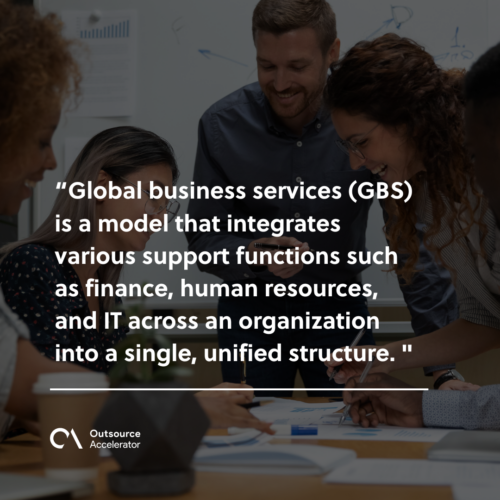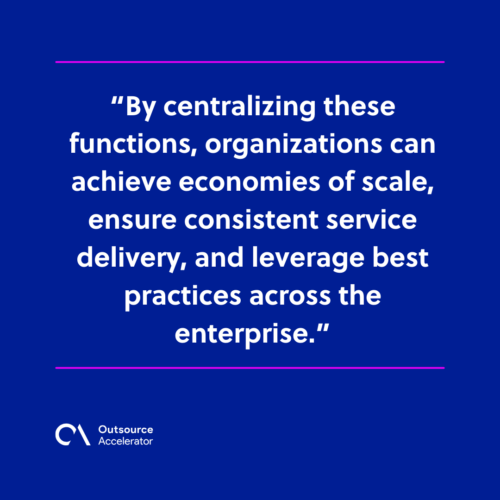Global business services vs. Shared services vs. Outsourcing: Differences explained

Today’s business environment requires organizations to continually seek ways to enhance efficiency, streamline operations, and reduce costs.
Among the various strategies employed to achieve these goals, three prominent models stand out: Global Business Services (GBS), Shared Services, and Outsourcing.
While each approach aims to optimize business processes, it does so in distinct ways, often leading to confusion about its specific roles and benefits.
Understanding their differences is crucial for businesses aiming to implement the right strategy for their needs. So, join us as we shed light on the similarities and differences amongst global business services, shared services, and outsourcing.
Whether you’re a multinational corporation, a regional firm, or a company in need of specialized external expertise, this guide will help you navigate the complexities of these service delivery models.
Global business services vs. Shared services vs. Outsourcing: Definition of terms
The global business environment has become interconnected and highly competitive. Many firms utilize these three key strategies to achieve their goals:
Global business services
Global business services (GBS) is a model that integrates various support functions such as finance, human resources, and IT across an organization into a single, unified structure.

GBS aims to provide consistent and efficient service delivery by leveraging global capabilities and standardizing processes.
It often employs advanced technologies and analytics to drive performance improvements and innovation across the enterprise.
Custom Market Insights reports that the global business services market is set for significant growth from 2023 to 2032.
It will be driven by rising demand for:
- Specialized business solutions
- Technological advancements
- The need for efficiency and cost savings
The market is anticipated to grow at a compound annual growth rate (CAGR) of around 21%. Valued at $203.7 billion in 2023, it is projected to reach $1,380.6 billion by 2032.
Shared services
Shared services refer to the consolidation of business operations that are used by multiple parts of the same organization.
These services typically include functions such as HR, IT, finance, and payroll, which are centralized into a single unit to serve the entire organization.
The primary goal of shared services is to reduce costs and improve service quality through economies of scale, standardized processes, and specialized expertise.
According to Global Market Insights, the shared services center market was $51.1 billion in 2023 and is expected to spike to over 16% CAGR between 2024 and 2032.
Outsourcing
Outsourcing is a strategic business practice of contracting out certain business functions or processes to external service providers.
Some of the commonly outsourced services include:
- IT roles
- Customer support
- Manufacturing
- Accounting
- Human resources
- Data entry
- Content creation
The main objectives of outsourcing are to reduce costs, access specialized skills, enhance efficiency, and allow the organization to focus on its core competencies.
Outsourcing can be conducted domestically or internationally, and when the service provider is located in another country, it is often referred to as offshoring.
Per Grand View Research, the outsourcing market worldwide is projected to grow by 9% each year from now to 2030.
Global business services vs. Shared services vs. Outsourcing: Key characteristics
Global business services, shared services, and outsourcing are three distinct models that manage and deliver various business functions.
Each model has its unique characteristics that organizations must know so they can choose the right approach based on their specific needs and strategic objectives.
| Key characteristics | ||
| Global business services | Shared services | Outsourcing |
|
|
|
Global business services
Here’s an overview of GBS’s key characteristics:
Integration and centralization of functions
In the GBS model, various business functions are integrated and managed centrally. This approach reduces role repetitions, improves coordination, and streamlines operations.
By centralizing these functions, organizations can achieve economies of scale, ensure consistent service delivery, and leverage best practices across the enterprise.

Global reach and standardized processes
GBS operates on a global scale, providing services across different regions and time zones.
This international reach ensures that all business units, regardless of location, have access to the same high-quality services.
Standardized processes are implemented to ensure consistency, efficiency, and compliance with global standards. Standardization reduces variability, enhances quality, and allows for easier benchmarking and continuous improvement.
Focus on delivering business value
The primary objective of GBS is to deliver tangible business value. This is achieved by aligning GBS activities with the organization’s strategic goals.
GBS focuses on driving operational efficiency, cost savings, and innovation, supporting the organization’s growth and competitiveness.
It centers on outcomes and performance metrics that reflect the value delivered to the business, such as improved service levels, faster time to market, and enhanced customer satisfaction.
Shared services
Now let’s discuss the main characteristics of the shared services model:
Internal consolidation of services
Shared services consolidate multiple business functions into a single, centralized unit within the organization.
This consolidation eliminates redundancy, improves coordination, and also leverages economies of scale, resulting in more efficient and effective service delivery.
Cost efficiency through centralized management
By centralizing the management of services, shared services can significantly reduce operational costs.
Centralized management allows for better resource allocation, standardized processes, and the elimination of duplicate efforts across different business units. This leads to improved financial performance for the company.
Typically geographically confined to certain regions or countries
Unlike global business services and outsourcing, shared services are often geographically confined to specific regions or countries.
This geographical focus allows for better alignment with local business needs and regulatory requirements.
It also facilitates closer collaboration and communication among team members, leading to more responsive and tailored service delivery for the organization’s internal customers.
Outsourcing
As for outsourcing, below are brief explanations of how it’s different from GBS and shared services:
Use of third-party providers
Outsourcing involves engaging third-party providers to handle specific business functions or processes. These external providers bring specialized skills, technologies, and resources.
They allow the organization to benefit from their expertise and capabilities without the need for internal development and maintenance.
Flexibility and access to external expertise
One of the significant advantages of outsourcing is the flexibility it offers. Organizations can:
- Scale services up or down based on demand
- Adapt to changing market conditions
- Quickly implement new technologies or processes
Outsourcing also provides access to external expertise and best practices, which can enhance the quality and efficiency of the outsourced functions.
Often driven by cost savings and focus on core competencies
Cost savings are a primary driver for outsourcing. By outsourcing non-core functions, organizations can minimize operational expenses, such as labor costs and infrastructure investments.
This helps companies allocate more resources to their core competencies—areas where they have a competitive advantage and can create greater value for their customers.
Outsourcing enables organizations to focus on strategic activities that drive growth and innovation.
Global business services vs. Shared services vs. Outsourcing: Challenges businesses may face
Before deciding which service delivery model to choose, businesses must be aware of the following drawbacks:
| Challenges businesses may face | ||
| Global business services | Shared services | Outsourcing |
|
|
|
Challenges of global business services
GBS can pose the following challenges:
- Complex integration. Integrating various functions across multiple regions and business units can be complex and time-consuming.
- Change management. Ensuringa smooth transition and buy-in from all stakeholders can be difficult.
- Cultural differences. Managing a global workforce with diverse cultural backgrounds can pose challenges in communication and collaboration.
- Regulatory compliance. Navigating different regulatory environments across countries adds complexity.
- Data security. Ensuring consistent data security standards globally is challenging.

Challenges of shared services
For shared services, growing firms must take into consideration the following:
- Initial set-up costs. Significant investment is required to establish shared service centers.
- Internal resistance. Employees and departments may resist changes and consolidation efforts.
- Service level consistency. Ensuring consistent service levels across all business units can be difficult.
- Scope creep. Managing and limiting the scope of services provided to avoid overextension can be challenging.
- Performance metrics. Establishing and maintaining effective performance metrics to measure success can be complex.
Challenges of outsourcing
Outsourcing, despite its advantages, also has these drawbacks:
- Quality control. Maintaining high standards of quality can be difficult when relying on external providers.
- Communication issues. Differences in time zones, languages, and communication styles can hinder effective collaboration.
- Dependency on vendors. Over-reliance on third-party providers can create risks if the vendor faces issues or fails to deliver.
- Loss of control. Outsourcing can lead to a loss of control over certain business functions or processes.
- Hidden costs. Unexpected costs related to managing contracts, transitioning services, and resolving issues can arise.
Global business services vs. Shared services vs. Outsourcing: When to use each approach
When choosing between GBS, shared services, and outsourcing, know that:
GBS is ideal for organizations looking to integrate and centralize functions globally, leverage standardized processes, and focus on delivering business value.
Shared services are best suited for organizations aiming to consolidate internal services within specific regions or countries to achieve cost efficiency and improved service quality.
Outsourcing is the right choice for companies seeking flexibility, access to external expertise, and cost savings by contracting out non-core functions to third-party providers.
Each approach has its unique advantages and challenges, and the right choice will depend on the organization’s operational requirements, strategic objectives, and resource availability.







 Independent
Independent




